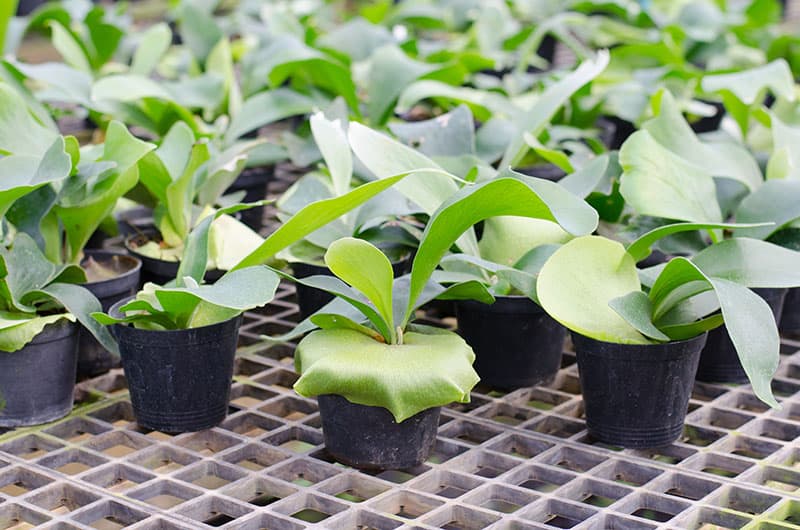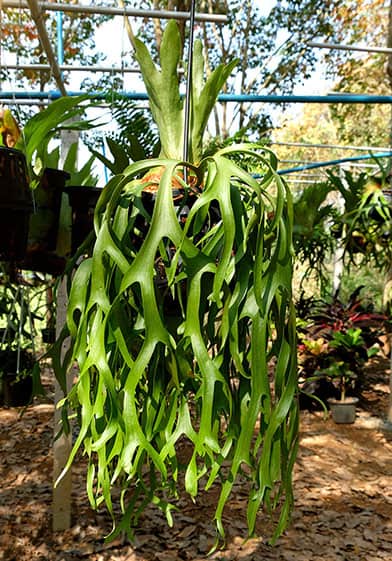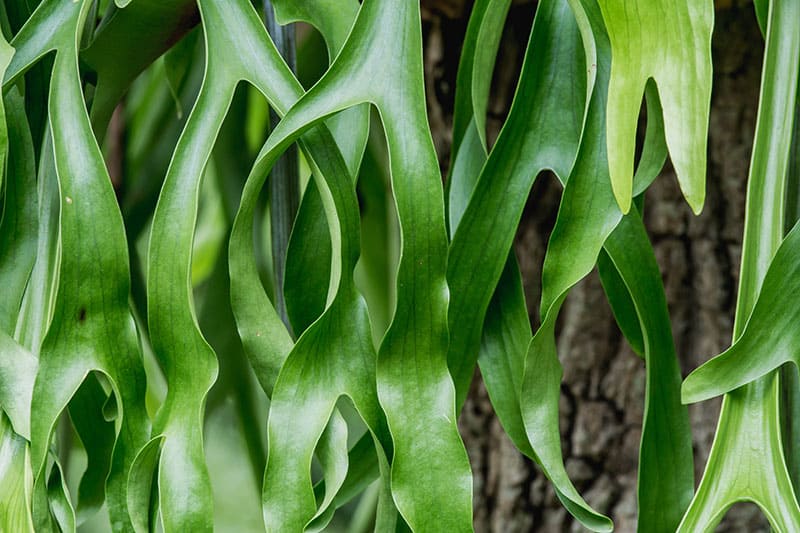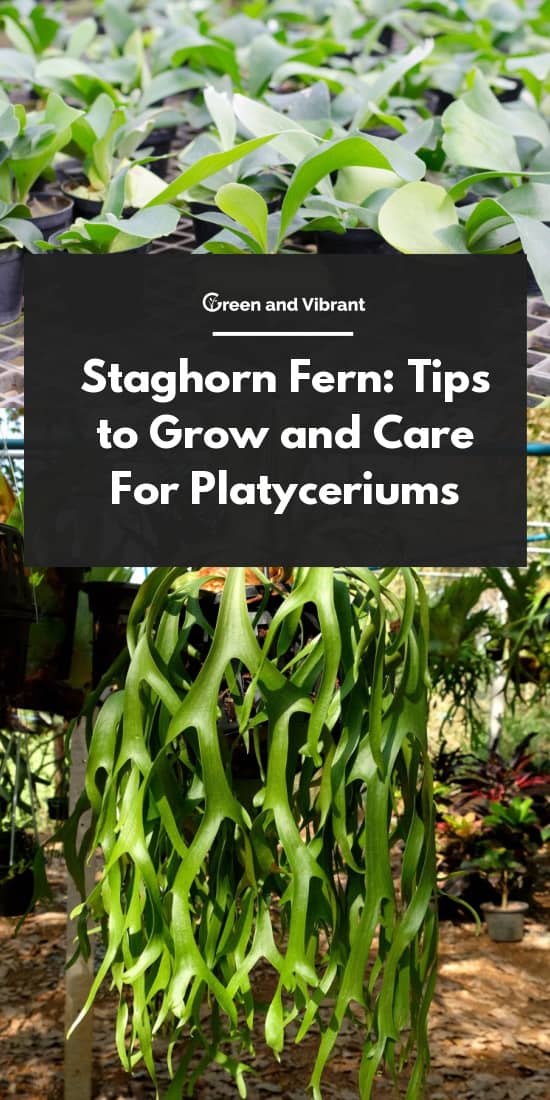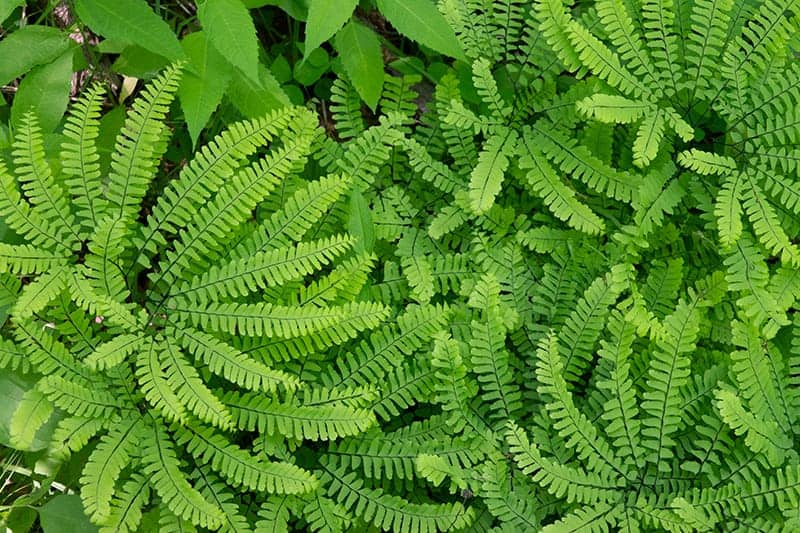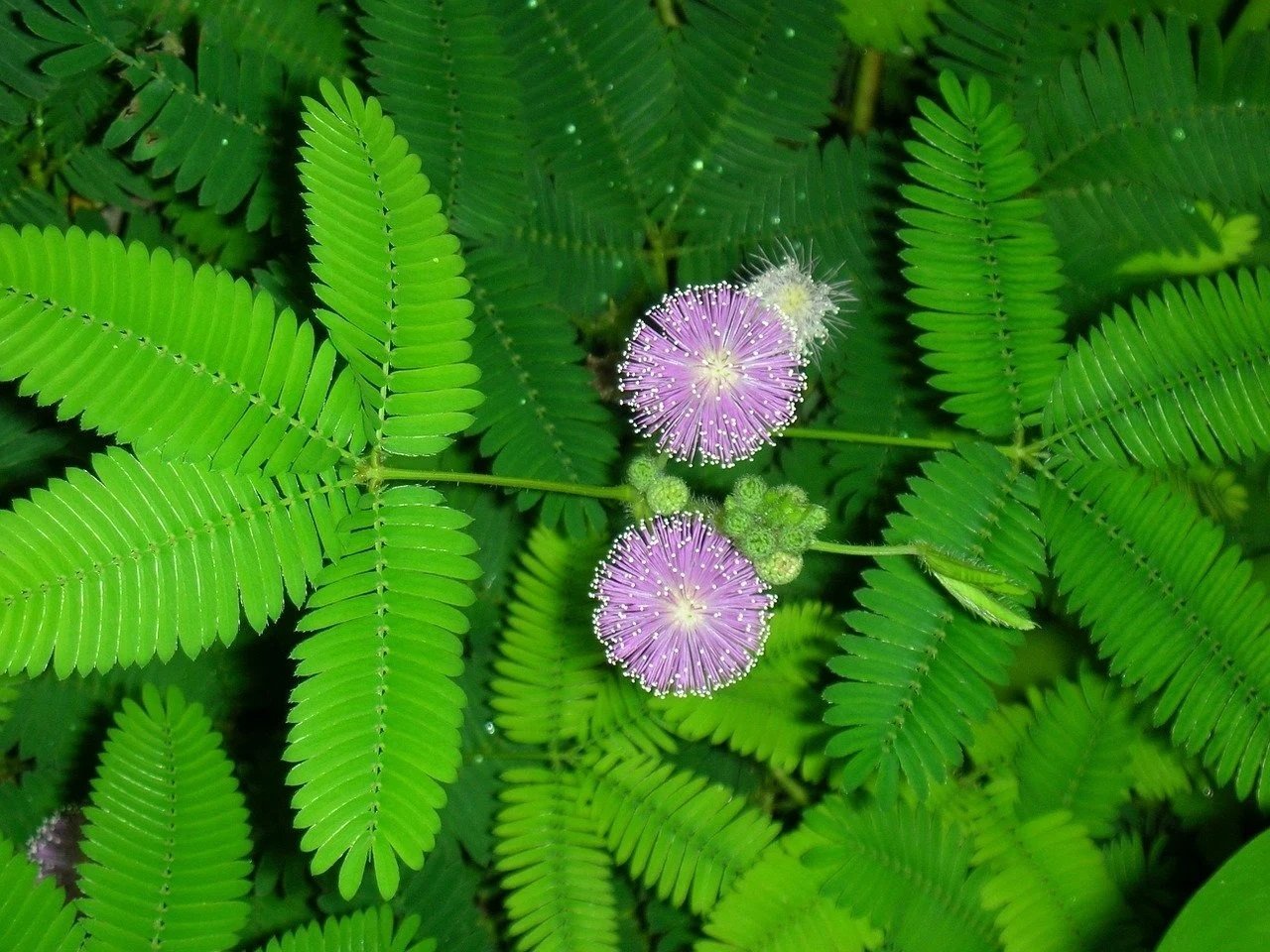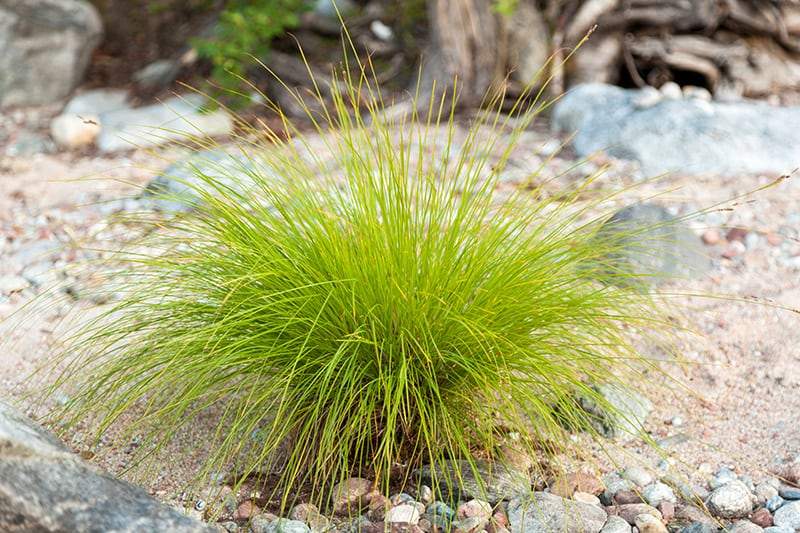- Home >
- Staghorn Fern – Tips to Grow and Care For Platycerium
Staghorn Fern – Tips to Grow and Care For Platycerium
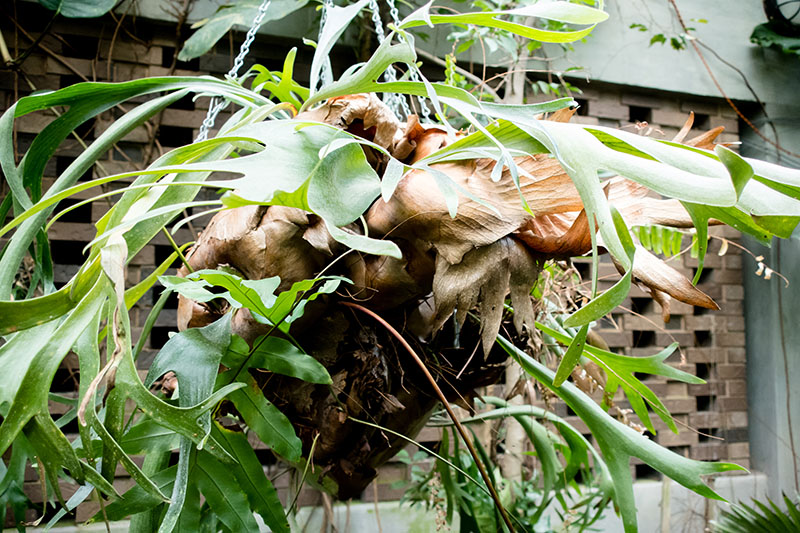
The Staghorn Fern is an unusual plant, being both an air plant and a fern, though it bears little resemblance to most ferns. In its natural environment of tropical forests, the plant grows on tree trunks or rocks, absorbing moisture from the humid air and collecting nutrients from the falling leaves of overhead trees.
The Staghorn Fern can be grown as a houseplant or outside in gardens with mild climates. Most typically, it is mounted on a surface and displayed on a wall, like a piece of art in its own right. The plant has two types of leaves: the lower heart-shaped leaves, which are brown when mature, and the plentiful antler-shaped leaves, which are the most decorative part of the plant and also show how the Staghorn Fern got its common name (San Diego Zoo- Animals and Plants).
If you can provide the right conditions, this plant is easy to care for and can be a stunning and unusual feature in your home.
Staghorn Fern Overview
Quick Facts
| Origin | Australia, Asia, and Africa |
| Scientific Name | Platycerium |
| Family | Polypodiaceae |
| Type | Evergreen epiphytic fern |
| Common Names | Staghorn Fern, Antler Fern, Elkhorn Fern, Antelope Ears |
| Ideal Temperature | 60-80° F |
| Toxicity | Non-toxic to people and pets (ASPCA) |
| Light | Partial shade to bright, indirect light |
| Watering | Water cautiously according to growing medium and conditions |
| Humidity | High |
Caring for Your Staghorn Fern
Growing Medium
Staghorn Ferns are epiphytes, meaning that they do not naturally grow in soil but instead use their roots to anchor themselves to host trees, where they live. Staghorn Ferns are not parasitic, because although they fix themselves onto trees, they do not take any nutrients from the trees or harm them in any way. Being an epiphyte means that Staghorn Ferns do not require soil to grow and instead can be grown at home on a variety of different growing mediums.
Many people choose to mount their Staghorn Fern on a wooden board or hang it from a wide basket. In these instances, sphagnum moss is generally the best growing medium. Fix it to your board or basket with wires, and then, securely attach your plant on top of this. The root ball will be quite small as Staghorn Ferns do not rely on roots to absorb moisture and nutrients, but the root ball does need to be making contact with the sphagnum moss.
It is also possible to plant a Staghorn Fern in a pot in a more traditional way, but you must not use standard potting soil as this will be too suffocating for the roots of the plant. A Staghorn Ferns roots are accustomed to having access to air and so will need a potting mix that allows for this. A mix of orchid bark and cactus soil should work fine.
Remember that in order to achieve the best health and growth from your plant, you need to try to mimic its natural environment as much as possible. As the Staghorn Fern grows on the side of trees in the rainforest, this is quite a difficult habitat to recreate, but most gardeners consider that hanging or mounting the plant on sphagnum moss is the best way to achieve this.
Water
In order to understand the watering requirements of the Staghorn Fern, you need to understand a little about the science of the plant and how it absorbs moisture and nutrients. The Fern has two types of leaves: fertile and sterile. On a mature Staghorn Fern, it is easy to quickly distinguish between the two because the fertile leaves are the long antler-shaped green leaves, while the sterile leaves are the brown and dry looking leaves at the base of the plant.
On younger plants, the sterile leaves start out pale green, but as they age, it is normal for them to become brown and look almost dead. They fulfill a very important purpose to the survival of the plant, so it’s vital that you don’t remove the brown leaves. The primary function of the fertile leaves is reproduction. They produce spores from which new Staghorn Ferns can be grown. The sterile leaves are how the plant feeds itself and protects itself. In its natural habitat, the brown leaves would catch falling debris and foliage from other plants, which, over time, would decompose and release nutrients that would be absorbed by the plant.
The sterile leaves are also able to absorb moisture, so in the humid environment of the rainforest, this would be the main way that the plant gets its water. The sterile leaves are also referred to as shield leaves, as they grow around the root ball, protecting it.
When the Staghorn Fern is grown as a houseplant or outside in a garden, the way you water it will depend on the growing medium you have used. In most instances, the plant will be growing on sphagnum moss. In this case, you need to slowly pour water onto the sphagnum moss with a narrow-mouthed watering can so that it becomes saturated. The roots of the Staghorn Fern will then absorb water from the sphagnum moss.
If the plant is potted in bark or a soil mix, then you can treat it similarly to an orchid. Water the plant a little at a time, being careful not to saturate the soil. You could use a few ice cubes each week as a watering method; as they melt, they will gradually water the plant, ensuring that the soil never becomes too wet. As the sterile leaves also absorb moisture, you can spray them with a water mist to water the plant, but be careful not to mist the fertile leaves. Sitting water on the fertile leaves can block their pores and interfere with the production of spores.
In terms of the amount and frequency of watering, the Staghorn Fern does not like to be too wet. In the rainforest, the roots of the Staghorn Fern receive water when it rains, but as they grow on the sides of trees, the rainwater would then drain through the plant and onto the forest floor. This would prevent the roots from ever becoming too wet.
To avoid overwatering at home, allow the growing medium to become dry between waterings, and only water when the fertile green leaves start to droop. While it is normal for the sterile leaves to become brown and crispy, it is not normal for the fertile leaves to brown or for dark patches to appear on any of the leaves. If this happens, it’s a sign that the plant has been overwatered and you need to adjust your watering method accordingly.
Typically, you can expect to be watering your Staghorn Fern once or twice a week during warmer months and once every two weeks during cooler months. The level of humidity will affect how often you need to water, as the sterile fronds will be taking in more water in times of high humidity and, therefore, require less manual watering.
Similarly, higher levels of light or heat mean the plant will need more water than when it is dark or cold. Pay attention to your plant and how it reacts to your watering methods. A heavy plant is likely holding a lot of water and doesn’t need more, whereas the reverse is true if it feels light. Dark tips on the fronds mean the plant isn’t getting enough water, and you will need to provide it with more moisture.
Soaking the Staghorn Fern is an alternative method of watering that you can use. You can do this instead of directly watering the plant if you do it often enough, or you can soak it occasionally between your regular waterings. To soak the plant, fill a large tub or container with water and submerge the plant. Face down is typically easiest, or for larger plants that struggle to fit all of the leaves into the container, you can soak the root ball instead. Allow the plant to soak for around twenty minutes, then let it completely dry before hanging it back up.
Temperature
In the mild and temperate climates of tropical rainforests, Staghorn Fern in their natural habitats are not exposed to the cold. When kept as a houseplant or outdoors in your garden you will need to make sure that these conditions are as closely replicated as possible. Ideal daytime temperatures for this plant will be somewhere in the region of 80° F, dropping to around 60° F overnight.
There are 18 varieties of Staghorn Fern, and most of these are not cold hardy, though there are some exceptions. The Platycerium alcicorne and the Platycerium hillii can tolerate occasional low temperatures of 40° F, while the Platycerium veitchi can tolerate temperatures dropping as low as 30° F. These are the best varieties of Staghorn Fern to have in your garden if you expect temperatures to occasionally dip to these points, though it should be noted that the plants cannot tolerate these low temperatures for sustained periods of time and should be brought indoors for winter protection.
For Staghorn Fern houseplants, the usual temperature of your home should suit the plant just fine. Ensure that the plant is not placed too close to areas which might experience cold drafts, such as doorways or air conditioning units. If you live in a climate which gets quite cold over winter, you’ll need to make sure that your heating is kept on, even if you go on vacation, to prevent the plant from getting too cold.
Light
Staghorn Ferns grow on tree trunks in their natural habitat of the rainforest and are shaded by the leaves of the taller trees overhead, receiving irregular streaks of sunlight through the movement of the foliage canopy above. From this, it’s easy to see why Staghorn Ferns do best in partial shade and bright, indirect light. At home or in your garden, display them in an area protected from direct sunlight, as this will harm the plant. Bright filtered light or shade is fine, although a mix of the two would be ideal.
Humidity
In its natural environment, the Staghorn Fern is surrounded by very humid air, upwards of 70 and 80%. It is very unlikely that the air within a home would ever be this humid, so you will need to take steps to increase humidity around the plant in order to help it thrive. The brown sterile leaves of the plant absorb moisture from the air as a means of supplying itself with water, so very dry air will not benefit the Staghorn Fern. One easy way to increase the humidity in your home is to use an electric humidifier, which releases tiny water particles into the air. This would be particularly beneficial if you have several humidity-loving houseplants.
The most common way to increase humidity for houseplants is with frequent water misting, but this should be avoided for the Staghorn Fern. Sitting water on the fertile leaves can block the pores and cause damage to the plant. You can mist the sterile brown leaves, as they absorb moisture, but be careful not to accidentally spray the upper green leaves.
If you have planted your Staghorn Fern in a pot, then you could use a pebble tray underneath it filled with water. As the water evaporates, it will increase the humidity around the plant. Just be sure that the water level is always lower than the pebble to prevent water from being absorbed up through the drainage holes of the pot by the soil. Obviously, if you have mounted your Staghorn Fern, then a pebble tray will not be an option. You might consider displaying it in an area of your home that is naturally more humid, such as a bathroom or kitchen. Staghorn Ferns also do well in greenhouses, where humidity is higher.
Feeding
Fertilizer is an essential part of Staghorn Fern care. When attached to a tree or rock in its natural habitat, the lower fronds of the plant collect fallen leaves from other plants and trees, which decompose down and, in the process, release nutrients that the Staghorn Fern absorbs. This method of obtaining nutrients will not occur when the plant is grown outside of its native location, so you will need to replace the nutrients in a different way. To do this, give your plant a regular fertilizer feeding. Using a diluted liquid feed with a 1: 1 ratio, you can feed the plant once a month.
Pruning
This plant does not need to be pruned. Sometimes, the lower fronds which have turned brown can be mistaken for dead leaves and get removed, but this is an error. Though they resemble dead parts of a plant, these sterile leaves perform vital functions for the Staghorn Fern and should not be pruned. They serve the purpose of absorbing moisture and nutrients to feed the plant, as well as shielding the root ball. There will come a time when these leaves expire and can be removed; you will know when this is the case because they will only be held onto the plant very loosely and can be easily pulled off.
Propagation
Staghorn Fern propagation can be achieved in two ways: from spores or from offshoots (Royal Horticultural Society). By far the easiest and quickest method is from offshoots. On a mature Staghorn Fern, you will see that offshoots develop on both the fertile and sterile leaf fronds. These offshoots are a young version of the plant attached to the mother plant by its own tiny root system. You can remove the offshoots by gently pulling or twisting them off.
If they do not come away easily, then it is too soon to remove them from the parent plant, and you should wait a little longer. Once you have an offshoot, you will need to plant it up straight away, whether that be mounted on sphagnum moss or in a bark and soil mix in a pot. If you don’t immediately supply it with its own growing medium, then it will quickly die. By removing the offshoots from the mature plant, you can both thin out the larger plant, making it less messy looking while achieving lots of new young Staghorn Ferns. For ease of doing, here is a good video to help you propagate the staghorn Fern plant by cutting
The other way to propagate this plant is from spores which are grown on the fertile reproductive fronds. They appear as small green lumps on the underside of the leaves early in the growing season. By late summer, they will have turned brown, and it is at this point that you can harvest the spores. One way to do this is to remove a frond from the plant and place it in a brown paper bag. The spores will release seeds by themselves, which you will find waiting at the bottom of the paper bag. Alternatively, you can scrape the underside of an attached frond with a knife to remove the seeds. You can then sow the seeds in a moist growing medium, covered with plastic and kept in a warm place. The seeds can take several months to germinate so this propagation method can take a lot of patience, with it being quite common to take a year to achieve plants which are strong enough to be potted on or mounted.
